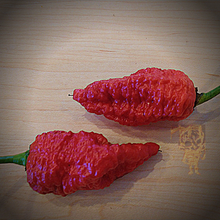The Naga Brain pepper is a superhot variety, a cross between a Brain Strain and a Dorset Naga, known for its extremely hot flavor, a "brain-like" wrinkled texture, and a complex taste that can be fruity and floral. It ripens from green to colors like red, yellow, or brown, and is used in hot sauces and other spicy dishes to provide intense heat.
Origin and Genetics
-
Crossbreed:The Naga Brain is a hybrid, typically a result of cross-pollination between a 7 Pot Brain Strain and a Dorset Naga pepper.
-
Lineage:It is closely related to the infamous Ghost Pepper, also a member of the Naga family of superhot peppers.
Appearance and Texture
-
Brain-Like Shape:The most distinctive feature is its bumpy, wrinkled, and convoluted surface, giving it the characteristic "brain-like" appearance.
-
Pod Color:Pods start green and ripen to various colors, including red, yellow, or a dark "chocolate" brown.
-
Size:Mature pods are relatively large, often 5-8 cm (2-3.2 inches) in length and 3-5 cm (1.2-2 inches) in diameter.
Flavor Profile
-
Fruity & Floral:Despite its intense heat, the Naga Brain offers a complex flavor with fruity and floral undertones.
-
Earthy & Tangy:You might also detect earthy notes and a tangy, slightly sour taste that emerges before the heat fully takes over.
Heat Level
-
Superhot:It is considered one of the world's hottest peppers, delivering an extreme and scorching heat.
-
Scoville Units:While official testing is inconsistent, it is believed to be as hot as or even hotter than some 7 Pot peppers, averaging over 1,000,000 Scoville Heat Units (SHU).
These seeds were harvested from plants grown in a controlled environment and isolation to preserve genetics.



